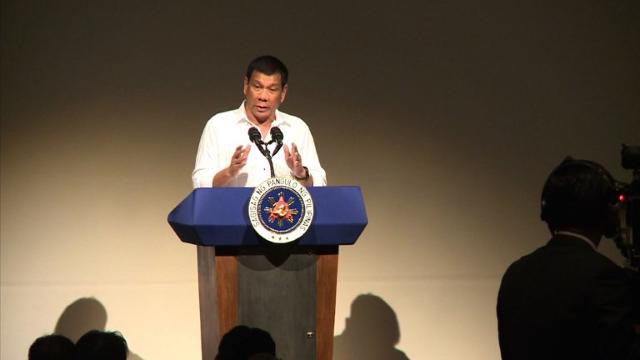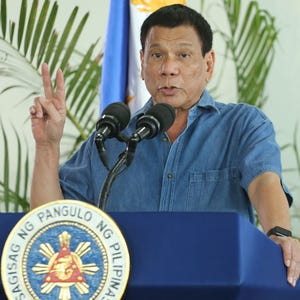
Philippine President Rodrigo Duterte says he wants U.S. troops out of his country in the next two years and is willing to scrap defense pacts with longtime ally Washington if necessary. Video provided by AFP Newslook
TOKYO — Philippine President Rodrigo Duterte ’s recent demand that U.S. troops leave his country would be a major blow to America’s new strategy to counter China’s growing strength and influence in the Asia-Pacific region.
Duterte said in Tokyo last week that he wants foreign troops to exit the Philippines within two years, even though Manila is a longtime U.S. ally. That came on the heels of his visit to China last month and as President Obama aims to "pivot" U.S. military, economic and diplomatic resources away from the Middle East to Asia.
As many as 600 U.S. troops are currently stationed in the Philippines, and at least two major training exercises involving American and other forces are held in the country each year.
The bases used by the U.S. military include two airfields located only minutes from the South China Sea , where China has built a string of artificial islands in waters claimed by neighboring countries, including the Philippines.
An international tribunal declared China’s claims invalid — a ruling Beijing has rejected — but the Obama administration fears that airfields and other Chinese infrastructure on these islands could allow Beijing to interfere with freedom of navigation in the South China Sea, a vital international waterway. Perhaps a sign that Duterte is cozying up to China, Beijing recently allowed Filipino fishermen to resume fishing part of the disputed waters.
Finding new locations for the U.S. troops and annual war games — as Duterte said he wants — will not be easy, defense analysts say.
"There's rarely a 'one-for-one' replacement when we lose military resources, such as access to bases in a country. Geography and political ties are always unique," said Grant Newsham, senior research fellow at the Japan Forum for Strategic Studies in Tokyo.
He said potential sites for an expanded presence include Australia, Singapore, Vietnam and the Northern Mariana Islands , a U.S. commonwealth in the Pacific Ocean.
Duterte, a tough-talking former prosecutor, has alarmed world leaders with a series of insults and seemingly off-the-cuff — and off-color — policy pronouncements since taking office in June.
He has called Obama a "son of a bitch," announced a “separation” from the U.S. and said he is prepared to "revise or abrogate agreements” with the United States, an apparent reference to a 2014 base-sharing treaty that allows American forces to be stationed at the five Philippine-operated military bases.
Although aides have walked back some of Duterte’s more eye-popping statements, defense analysts have nonetheless expressed concern.
“We still don't know what President Duterte exactly means about U.S. military presence,” said Tetsuo Kotani, senior fellow and maritime security specialist at the Japan Institute of International Affairs in Tokyo.
This would not be the first time that U.S. forces have been booted from the Philippines, which is a former U.S. colony.
Meanwhile, U.S. forces continue to train in the Philippines, including taking part in two large-scale annual exercises with Philippine forces. One of those exercises this year included 8,600 troops from the United States, Philippines and Australia, along with observers from 11 other countries.
Plus, a contingent of U.S. A-10 attack planes were previously stationed at Clark Air Base, now operated by the Philippines.
As part of the diplomatic "pivot," the United States has sought to spread its forces throughout the region, operating from locally run facilities rather than establishing bases of its own.
Navy littoral combat ships now operate from Singapore. About 1,500 Marines are based "rotationally" in Darwin, Australia . In November, U.S. and Japanese forces will conduct amphibious warfare exercises at Tinian Island , in the Northern Mariana Islands, a location that has been discussed as a potential permanent joint-training facility.
During Duterte's three-day visit to Japan, he lavished praise on the country, America’s closest ally in the region. He also agreed to joint naval patrols.
Whether Duterte will complete his threat to expel U.S. forces from the Philippines remains to be seen, said Narushige Michishita, director of the Security and International Studies Program at the National Graduate Institute for Policy Studies, in Tokyo.
Michishita said Duterte may be trying to play the region's two superpowers — China and the United States — against each other.
“If he’s playing a game, that’s not bad because eventually he’ll come to a reasonable position which is consistent with the Philippines’ interests. But if he’s not, that would be bad. So we’ll just have to wait and see,” Michishita said.


No comments:
Post a Comment